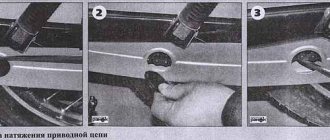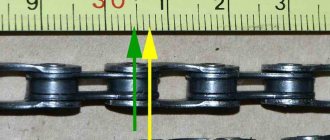After how many kilometers should the oil in a moped (moped engine) be changed?
The period for changing the oil in a moped is determined by the operating rules of the manufacturer and is carried out in accordance with the table of Maintenance Frequencies during the warranty and post-warranty period.
For mopeds, the first oil change is made after 500 kilometers. Each subsequent replacement is every 1500 kilometers. Each manufacturer gives its own replacement periods, which also depend on the moped model. If we talk roughly about the recommended average mileage, then you can focus on the following figures:
Of course, the best option is to look at the operating instructions for a particular moped; in the same instructions you can find out what specific oil the manufacturer recommends.
Moped engines are different, different manufacturers, different oil.
It is also important to take into account whether the vehicle is new, during running-in, after running-in, or the moped has been in operation for a long time (there is a frequency of oil changes).
But if in general everything is “from scratch” (new moped, needs running-in), then for example, here’s the “Alpha” moped
Then every one and a half to two thousand kilometers and an oil change.
Along with the oil, it doesn’t hurt to change the chain after the same mileage (2,000 km).
Here, it is also important to note that the mentioned periods are the limit beyond which it is better not to go (that is, the maximum permissible), and you can change the oil (if funds allow) at least every day, the engine will not get any worse.
A moped is usually a four-stroke engine, but in fact a motorcycle.
You need to change the oil on a new moped after 200 kilometers for the first time, after 500 kilometers for the second time (this is the engine break-in) and every 2000 kilometers thereafter.
A moped with a four-stroke engine can be filled with regular car oil 10W-40 or 10W-30; it is not necessary to buy expensive oils that are suitable for super expensive high-speed bikes!
You just need to reduce the oil change period from 2000 to 1500 kilometers, and of course it doesn’t matter how little you drive, but be sure to change the oil in the moped engine in the spring before the start of the operating season!
Source
Scooter with four stroke engine
For scooters with a regular gearbox, 4t oil is suitable, but if your scooter has a CVT gearbox, then you need gear oil. In the case of a 4t scooter, the choice of oil comes down to the same principle as for a 2t. That is, it all depends on the riding style, the technical condition of the moped and also its age. If we talk about four-stroke mopeds, then it is recommended to fill them with 10w-40 oil. In principle, a moped can run on regular car oil, but use such oil at your own peril and risk. The oil must protect all rubbing parts well, and there are a large number of them in the engine. And the scooter clutch especially needs high-quality oil, since it literally floats in oil.
If we are talking about what kind of oil to pour into cubic capacity motorcycles, then two-stroke synthetic is better. This way the cylinder-piston group will remain clean and well preserved. This oil is the most resistant to various temperatures. Also, synthetic scooter oil produces less soot, which settles in the muffler and clogs it.
Why change the oil
I met a person who did not change the oil for 3 seasons. His ATV was being repaired and there was little left of the oil, everything was covered in soot. And the engine was working in this one, it’s good that it was still working at all. But it significantly reduced its service life, and the repairs cost a pretty penny.
As mentioned, a good synthetic oil prevents the formation of carbon deposits and is resistant to temperatures. Carbon deposits interfere with engine operation and reduce its service life, complicate the life of compression rings and cause overheating. And given that the amount of carbon deposits is constantly increasing, plus constant overheating, repairs will not take long. And expensive motorcycles require expensive repairs. Therefore, it is not recommended to skimp on oil.
And what will happen if you don’t change the oil, you will find out from the video:
How much oil to put in a scooter
Each scooter needs a different amount of oil. But using the golden rule this can be easily understood. After all the oil has been drained from the crankcase, you need to measure how much of it came out and then fill in the same amount plus 3-5 percent. If the scooter is new, then you don’t have to add 3-5%, and fill in as much as you drain.
Scooter rider
It is very important to change the oil on your scooter on time.
But what to do if you don’t know exactly when to change the oil. After how many kilometers? On the one hand, you don’t want to harm the engine by changing the oil too late. But on the other hand, it is not economical to change the oil very often. In this article we will talk about how often to change the oil in a scooter. Ideally, you should find a manual specifically for your scooter model. Because each device has its own characteristics. Some can travel 5-6 thousand km. before changing the oil and this is normal for them. While in others, you need to change the oil every 2-3 thousand km. Still others can drink oil as they use it (as a rule, this only applies to two-stroke scooters), and in addition to changing the oil after a certain mileage, it also needs to be constantly topped up. Therefore, you should know the features of your scooter and, ideally, have a manual.
But how long does it take to change the oil in a scooter if there is no manual ?! You need to find a middle ground or ask someone who has a scooter of your model.
When to change the oil in a used scooter
If you took a used scooter. Then ask the owner when he last changed the oil and how often it needs to be changed. If you do not have contact with the owner, then check the condition of the oil. You need to put a drop of oil on your finger. There should be no sediment or the like in it. It must be clean. If there is sediment, the oil needs to be changed. Change the oil regularly every 3-4 thousand km. mileage
Write down when you changed the oil so you don't forget. Because if now it seems that this mileage is easy to remember, then over time in a few months you can completely forget it.
Don't skimp on oil and don't delay replacement. Because if you fill in oil of poor quality or do not change it in a timely manner, this reduces the service life of the engine. And you will have to do expensive major repairs sooner.
It may be useful for you to know: How much oil to pour into a scooter.
If you want everything to be perfect and the golden mean is not suitable for you. Then you can find out how often to change the oil in your scooter in the comments to the article. To do this, write the model of your scooter.
Source
Changing the scooter gearbox oil
A gearbox is a mechanism for reducing the speed of the driven shaft in order to increase torque. Simply put, it converts high clutch shaft RPMs into low (but powerful) wheel RPMs. The gearbox consists of several gears and bearings. All its parts are in constant rotation when driving and are under very serious load.
Therefore, the key to long-term performance of the gearbox is good care of it. Fortunately, maintenance is very simple: you need to change the oil in the gearbox in a timely manner. I believe that the oil should be changed once a year or every 2 thousand km.
In order to change the oil in the scooter gearbox, we will need the following tools:
- container for draining old oil
- key for 10
- a syringe or, at worst, a funnel
- transmission oil
What to fill the gearbox with?
There are three options.
1. There is a special Motul Scooter Gear gear oil. That's what I used at first. The disadvantages of this oil are as follows: the tube has a volume of 150 ml, while in my scooter the gearbox requires 90 ml, that is, one tube is one and a half refills, neither this nor that. And it is inexplicably expensive (about 250 rubles). The only plus: the convenient tube spout.
However, you can use any other automotive gear oil with a viscosity of 80W-90 or 75W-90. For the same money you can buy a liter of “non-scooter” oil, and it will work exactly the same.
2. Since the scooter gearbox does not contain hypoid gears, any motor oil with a viscosity of 10W-30 can be used as transmission oil. Motor oil is even preferable if the scooter is used in the off-season at temperatures below +7 ° C, because it is more liquid.
3. And finally, the most optimal option, in my opinion, is oil for automatic transmissions (ATF), that is, ATF transmission fluid. This oil has the best fluidity (which is especially important at low temperatures, although this is not so important on a scooter), it perfectly protects gears, and has a reduced tendency to foam. Oh yes, it also has a beautiful red color :). The price range for ATF is from 170 to 700 rubles per liter, and for a scooter you can take the cheapest one.
How to drain old oil
First of all, the oil should be changed after a trip so that the sediment rises from the bottom. If your scooter is cold, you can rev it up for a few minutes on the spot.
If the scooter has a drain bolt, everything is very simple: put a container under it, unscrew it, drain the oil, tighten it.
If there is no drain bolt (like mine), then draining and filling is done through a single bolt. In this case, the scooter must be tilted on its side to drain the oil.
If you haven't changed the oil in a while, it will look something like this:
The metallic color indicates abrasion of the working surfaces of the gears. But it’s not scary, it’s a normal process.
How to add new oil
The oil volume is indicated on the gearbox housing. For example, mine says “OIL 0.09 L”, i.e. 90 ml.
It is most convenient to measure and fill the indicated volume using a medical syringe (buy the largest one, at least 20 ml). But if you don’t have a syringe, you can simply fill the oil to the lower thread level of the filler bolt. This is just the right amount. Of course, the scooter must be in an upright position.
When tightening the bolt, do not use excessive force, since the motor housing is made of silumin, the threads are very easy to twist.
Please note: This article and the images in it are subject to copyright. Partial or complete reproduction on other resources without permission is prohibited.
How to change the oil in a 4T scooter engine with your own hands?
Motor oil plays an important role in the engine. The liquid lubricates moving parts, preventing temperature increases at the point of friction. This ensures optimal performance of the power unit, extending its life for many years to come. Oil starvation leads to accelerated wear of engine parts and inevitable breakdown. The four-stroke scooter engine is no exception.
When to change the oil?
The procedure for changing the oil in a four-stroke scooter engine depends on the specific model. Each vehicle has individual characteristics. Some owners can drive up to 5 thousand kilometers and not change the oil, while others have to change it every 2-3 thousand kilometers.
The oil in a new scooter needs to be changed after 300 km. This must be done because break-in lubricant is poured at the factory. It is not recommended to drive on such liquid for a long time. The second replacement should be made after approximately 700 km. Further procedures should be carried out at each technical inspection (approximately once every 3000-4000 km).
Motorcyclist
Trouble-free and long-lasting operation of your scooter's engine largely depends on timely replacement of engine oil. The work of changing the engine oil of your scooter is one of those types of work that it is advisable to do yourself. By changing your own engine oil, firstly, you save your money, and secondly, you will have confidence that under the guise of a brand they won’t fill you with some kind of mud, if at all...
The frequency of changing engine oil should be specified in the instructions for your scooter; if you do not have instructions, then in this case you can use general recommendations.
The first engine oil change in a new scooter after 300 km of the scooter's mileage The second engine oil change in a new scooter after 800 km of the scooter's mileage The third engine oil change in a new scooter after 1,500 km of the scooter's mileage Subsequent engine oil changes every 2,000 km of the scooter's mileage
A small clarification: when operating the scooter on dusty roads, the engine oil should be changed more often than recommended in the instructions.
We put the scooter on the central stand, warm up the engine for 10-15 minutes or, best of all, start changing the oil immediately after the trip, prepare a suitable container for the used oil, look for the drain plug on the engine (indicated in the photo), take a socket wrench and unscrew the drain bolt . Attention! The operating temperature of the engine can reach 120-150 degrees; when changing the oil, be careful to avoid burns.
We look for the oil filter plug on the engine and unscrew it.
After removing the oil filter, with the ignition off, vigorously turn the crank several times so that the remaining engine oil is completely removed from the engine. After removing the oil filter parts from the engine, be sure to wash them in gasoline and blow them with compressed air.
Before installing the filter and drain plug in place, carefully wipe the holes with a clean rag, apply sealant (preferably) to the connectors and screw them into place.
We take the engine oil recommended by the manufacturer, for greater ease of operation, insert a funnel into the filler hole and pour the required amount of oil into the engine.
How much oil to pour into a scooter?! We pour as much as we drained. If you don't know how much, pour 90% of capacity. Although it is different for everyone, this is only an average percentage so as not to cause harm, and how much oil to pour into a scooter should be found in the instructions for a specific model.
To check the oil level, unscrew the dipstick, wipe it with a rag and insert it into the filler hole (without twisting); the oil level at the end of the dipstick should be approximately within the same range as in the photo.
After changing the oil, when you start the engine, do not immediately give high speeds, let the engine idle for a while, this is necessary so that the pump has time to pump oil through the system.
P.S. if you are looking for a new scooter clip there is none 
What oil should I use?
Available types of oils for four-stroke engines: SAE 5W-20 or 10W-40. Depends on the manufacturer. If the vehicle is often operated in high temperature conditions, it is better to choose a motor oil with a high viscosity index.
What to look for when choosing oil? First of all, on the oil indices, which should be present on the canister label. The chemical composition is also no less important. In addition to the index, the exact amount of additives from the fluid manufacturer is used.
For a four-stroke scooter engine, you can use not only oil that is intended for scooters, but also for equipment: walk-behind tractors, lawn mowers, chainsaws and others.
Choosing scooter oil
When purchasing an oil fluid, you need to focus on the viscosity recommended by the manufacturer, taking into account the temperature indicators of the region of use (seasonality). Lubricant mixtures for scooters are usually systematized according to the type of engine for which they are intended to operate.
The limitations are caused by the fundamental difference in the lubrication systems of two- and four-stroke engines. Therefore, when choosing oil for a moped, you must strictly follow the operating instructions and focus on the individual characteristics of the existing model.
Two stroke engine
Two-stroke engines installed on scooters are lubricated with oil fluids, which are first mixed with fuel and then burned in the cylinders along with it. Hence the specific requirements for this group of oils:
- good solubility in gasoline;
- low ability to form carbon deposits on the rings and internal surfaces of the muffler;
- protection of engine parts from wear and corrosion;
- low ash content;
- low smokiness of exhaust gases.
Special brands of oils for two-stroke engines:
- Eni i-Ride Scooter 2T is a semi-synthetic lubricant that guarantees high-quality engine operation even at high ambient temperatures. The oil has good cleaning properties, anti-wear characteristics, low ash content and low CO content in exhaust gases.
- Racing Scooter Synth 2T is a synthetic oil fluid with low smoke, good wear resistance and high lubricity. Prevents the appearance of alkaline and acid deposits on the internal surfaces of the cylinder block. Used for separate and mixed lubrication of two-stroke motorcycle engines.
Widget from SocialMart
- Racing Scooter 2T Basic is a mineral oil for low-power engines. It cleanses the system well of combustion and wear products. Has optimal lubricity. Can be used for both air- and water-cooled motors.
Scooter with four-stroke engine
Oil for scooters with a four-stroke engine is designed to work in difficult operating conditions. This is due to complex city traffic, where there are frequent stops, alternating driving modes, sudden acceleration, etc.
The specificity of engine lubrication is that some parts are lubricated under pressure using an oil pump - these are the main bearings, the crankshaft and the cylinder head. The remaining rubbing surfaces are washed by spraying or oil mist.
Operational requirements:
- high thermal properties;
- low viscosity at low temperatures;
- low ability to form varnish deposits and soot;
- antioxidant qualities;
- protection of parts from corrosion;
- stable cleaning properties.
Recommendations:
- MOTUL Scooter Power 4T is a synthetic oil for powerful scooters with four-stroke engines. The lubricating fluid works well in urban conditions, reduces the friction force in the contact areas of the parts, and ensures stable operation of the clutch mechanism immersed in the engine crankcase. It has good antioxidant, anti-corrosion and dispersing characteristics.
- LIQUI MOLY Racing Scooter 4T is a mineral oil fluid for four-stroke engines. Provides high-quality lubrication of engine rubbing surfaces. It has high anti-corrosion, thermal and anti-wear properties.
- ENI I-RIDE SCOOTER 4T is a semi-synthetic oil with high performance characteristics. The technical fluid has no temperature restrictions and guarantees reliable wear protection even in the most extreme conditions. Synthetic additives present in the mixture provide good non-stick and washing properties.
The process of changing the oil in the engine 139QMB of a 4t scooter
Necessary tools for changing the oil in the engine 139QMB of a 4t scooter:
Before starting the procedure, you need to warm up the scooter engine. The oil will become highly fluid and will quickly drain from the system. The next sequence of actions is as follows:
The process of changing the oil in a four-stroke scooter engine is complete!
Changing the oil in engines of various scooters
Changing the oil in other scooters, such as Storm Lzw 500, Honda Tact, Chinese scooter, as well as the 157QMJ engine, is carried out according to a similar scheme. The exception is the location of the drain and fill holes. As a rule, on all scooters these holes are on the left side (determined by the driver's seating position).
A brief process for changing engine oil on other scooter models:
Preliminary preparation of the scooter
Before replacing, the engine must be warmed up for 5-10 minutes at idle speed. The oil will become thinner and mix with the dirt and sediment particles that have accumulated at the bottom. The space around the drain and fill bolt is cleared of dirt.
Immediately you need to prepare a funnel and a container for draining with a capacity of up to 2 liters. It should be easy to dispose of and prevent possible spillage. Do not forget that reusing used oil is strictly prohibited.
Consequences of untimely oil changes
The consequences of untimely oil changes in a scooter engine are disappointing.
Possible breakdowns of the scooter:
All this indicates that the oil in the system has not been changed for a long time. As a result, the channels become clogged, which will also negatively affect the engine components. Component wear is inevitable. Therefore, if the vehicle owner purchased a scooter in maintained condition, the first thing to do is replace the lubricant in the engine.
Source
Motorcycle oil change
The health and productivity of a vehicle depends on the quality of the oil poured into the engine. With periodic maintenance, the engine works properly and does not create any problems for the motorcycle owner. But if the engine oil is changed rarely and incorrectly, the motorcycle will quickly become unusable, and repairs will be very expensive for the owner. The process of changing the oil contains many nuances, so before you begin this difficult task, find out how to properly change the oil in a motorcycle.
Periodicity
Every motorist has thought at least once about how often the engine oil should be changed. In the operating instructions they say one thing, on websites for motorcycle racers they say something else, and friends from the club say something else. To understand this topic, it is enough to know the following.
The frequency of oil changes depends on your driving style. With frequent gear changes, sudden acceleration and braking, as well as constant speed changes, the oil quickly turns black. This style of riding is typical for cities: stops at traffic lights alternate with rapid increases in speed, which is why the motorcycle engine works at the limit. Large loads on the engine require additional resources from the oil, so it has to be changed many times more often. In urban conditions, a motorcycle can travel 5000-6000 km with semi-synthetic oil, and up to 7000 km with synthetic oil. If the motorcycle is used for enduro riding and long-distance travel, the oil can be changed every 11,000-12,000 km.
Changing the oil on the training motorcycles of the Autofactor motorcycle school is based not on mileage, but on the number of astronomical hours worked on the site (motor hours). In the range of 300 – 350 hours, the oil and oil filter are changed (once a month), plus the technical condition of the motorcycle is diagnosed. Maintenance and repair of educational equipment is included in the cost of training for category “A”.
Another condition to pay attention to is roads. Motorcycles do not like uneven roads: gravel, dirt roads, potholes and potholes. On such roads, the engine oil will deteriorate much faster, so you will have to change it more often.
Some people believe that it is enough to follow the recommendations of the factories, and everything will be fine. But this is a misconception. The fact is that when calculating such parameters, factories use average values. That is, these figures will be reliable for motorcycles used under ideal conditions: at medium tachometer speeds, riding with the throttle partially open and the engine not overheating. Motorcycle manufacturers do not know in what conditions a particular vehicle will be used. Driving in dusty, dirty or wet areas, constantly idling in traffic jams, daily jerks on sportbikes - all these situations require attention and reduction in oil change intervals.
Important! Even the highest quality oil gradually loses its lubricating properties. Oxidation processes constantly occur in the oil; in 1 year its effectiveness decreases by almost 40%. Therefore, even if you haven’t reached the level required for an oil change in a year, check the quality of the oil and replace it if necessary.
Scooter with four stroke engine
For scooters with a regular gearbox, 4t oil is suitable, but if your scooter has a CVT gearbox, then you need gear oil. In the case of a 4t scooter, the choice of oil comes down to the same principle as for a 2t. That is, it all depends on the riding style, the technical condition of the moped and also its age. If we talk about four-stroke mopeds, then it is recommended to fill them with 10w-40 oil. In principle, a moped can run on regular car oil, but use such oil at your own peril and risk. The oil must protect all rubbing parts well, and there are a large number of them in the engine. And the scooter clutch especially needs high-quality oil, since it literally floats in oil.
If we are talking about what kind of oil to pour into cubic capacity motorcycles, then two-stroke synthetic is better. This way the cylinder-piston group will remain clean and well preserved. This oil is the most resistant to various temperatures. Also, synthetic scooter oil produces less soot, which settles in the muffler and clogs it.
Why change the oil
I met a person who did not change the oil for 3 seasons. His ATV was being repaired and there was little left of the oil, everything was covered in soot. And the engine was working in this one, it’s good that it was still working at all. But it significantly reduced its service life, and the repairs cost a pretty penny.
As mentioned, a good synthetic oil prevents the formation of carbon deposits and is resistant to temperatures. Carbon deposits interfere with engine operation and reduce its service life, complicate the life of compression rings and cause overheating. And given that the amount of carbon deposits is constantly increasing, plus constant overheating, repairs will not take long. And expensive motorcycles require expensive repairs. Therefore, it is not recommended to skimp on oil.
The first time you should change the oil after 500 km, then every 1000. It is also recommended to change the oil after carrying out work on the cylinder: replacing the cylinder, removing the cylinder head, etc., since during these works, even if everything was done carefully, there is a possibility dirt and metal particles getting into the engine. You will need a wrench with a head (most likely 19).
The oil change must be carried out when the engine is warm - this way the oil becomes more fluid, and dirt, if any, rises from the bottom of the crankcase, mixing with the oil. The scooter must be placed on the center stand.
Work order:
- Unscrew the filler cap (dipstick), located on the right side of the engine, next to the generator
- Place a container (about 1 liter) under the drain hole to drain the used oil and unscrew the drain plug counterclockwise. To unscrew, use only the head - an open-end wrench can damage the drain plug, which is made of aluminum. Under the plug there is a spring and an oil filter - mesh
- Drain the oil
- Wash the drain plug and filter in gasoline
- Screw in and tighten the drain plug. Don't overdo it - remember that the plug and crankcase are made of aluminum. Excessive force may damage the threads.
- Pour 800 ml of engine oil into the engine through the filler neck using a suitable funnel.
- Tighten the filler cap
How to look after your oil
Despite current recommendations on how often you should change your oil, the best way to ensure your engine's health is through periodic checks. The engine oil is changed in two cases: if it runs out or if it has deteriorated. To check the oil level, place the motorcycle on a level surface. If the motorcycle has only one side stand, try to fix it on the weight in a more or less level state. When checking the oil, the engine must be cool and the oil not viscous. If the motorcycle has recently been started, wait 30-50 minutes until it cools down and the oil drains down.
Level check
Excess oil in the crankcase causes hydraulic shock, squeezed out oil seals and seized pistons. A lack of oil can result in a seized engine and a failed engine. You can find out the fluid level either using a dipstick or through an inspection window. If the crankcase is more than half empty, add oil. Otherwise, oil starvation will begin.
The dipstick is attached to the inside of the oil filler cap. To check the oil level, unscrew the dipstick counterclockwise and wipe dry with a rag or paper towel. After this, lower the dipstick into the oil filler neck until it stops, without twisting it. Carefully pull it out, holding it horizontally and not allowing oil to spill on the dipstick. The oil level should be between the “High” and “Low” values. If necessary, add oil or drain it.
Checking the engine oil level
Place the scooter on the center stand.
When checking the oil level, the scooter must be placed on a known level surface. Checking the oil level should occur after the scooter has warmed up for 2-3 minutes.
Checking the oil level is carried out using a dipstick, see Fig. 1, 2. Before measuring, the dipstick must be wiped with a clean rag.
When purchasing a book in PDF
1. You will be able to download the book immediately after payment.
2. The book will be downloaded in PDF format, and you can download it to any device.
1. All books are of ideal quality, since we work with publishers directly.
2. Electronic books are in no way inferior to paper books and are their complete analogue.
3. Our company has offices in Ukraine, Russia and Poland, you can always contact us at a specific address.
4. All payments on the site are maximally protected and are made using global payment systems.
Payment for goods and downloading of the book in electronic form (PDF format) is made on the website.
To do this, you need to find the book you are interested in and click on the “Buy” button. The price of the book is indicated on the button.
For convenience, the price on the website for residents of Russia, Belarus and Kazakhstan is presented in rubles.
For residents of Ukraine in hryvnias, and for all other countries - dollars.
After clicking on the “BUY” button, you will be taken to the payment page, where you can select a payment system with which you can pay for the selected book using any bank card (Visa, MasterCard, MIR, etc.)
There are four payment systems available on the website for payment:
- Yandex (payment from any bank cards, Yandex Money account, QIWI Wallet, terminals, etc.);
- Portmone (payment from any bank cards, Portmone account);
- PayPal (payment from any bank cards, PayPal account);
- WebMoney (payment from any bank cards, payment from WebMoney wallets).
Consequences of untimely replacement
If you constantly delay caring for your motorcycle, increasing the intervals between oil changes, the results will not be long in coming. Damaged oil ceases to perform its functions, and the mechanism begins to be damaged. The oil thickens, becomes too viscous and, instead of making engine operation easier, makes it more difficult. The engine begins to overheat, parts rub against each other, as the lubricant does not work efficiently, and the condition of the vehicle deteriorates. Here is a list of malfunctions that are caused by untimely oil changes:
When to change the oil
There is no exact answer to this question. Most motorists prefer to change the oil regardless of the time of year. Professionals advise changing the oil twice a year: before wintering, to “preserve” the motorcycle, and at the beginning of each season, that is, in the spring. Usually the motorcycle is not used in winter. If the oil was burnt or used before wintering, it can seriously damage the engine after 3 months of standing in the cold. While the motorcycle is not in use, the oil “does not work”, but is actively oxidizing, and by spring its quality may deteriorate significantly. To avoid problems associated with spoiled oil, it is recommended to change the oil twice a year.
Why is fresh scooter gear oil necessary?
One of the most important components of a scooter can rightly be called the gearbox. It is responsible for timely reducing the speed of the driven shaft, thereby increasing torque. That is, it converts high shaft and clutch speeds into fairly powerful, but low wheel speeds. This part consists of a number of rubbing elements (gears and bearings) that undergo enormous loads, and, as expected, they need good care. It is the transmission oil that provides such care.
It is an oil doped with various functional additives. The main function of transmission fluids can be called protective, as they protect the surface from wear, corrosion, seizing, etc. In addition, thanks to them, energy losses are reduced and heat removal from friction surfaces is ensured. Shock loads, vibrations and noise in gear drives are also significantly reduced.
Oil change tools
It is impossible to change the oil in a motorcycle engine with bare hands. To avoid damaging any parts of the mechanism, use the recommended tools. Before starting the procedure, prepare all the necessary tools and place them next to you, since you cannot leave the motorcycle unattended. In addition, hands stained with motor oil will make it difficult to find missing tools.
Important! Wipe down tools before and after use. When changing the oil, all tools must be clean, free of dirt and dust. The fact is that even a small grain of sand that accidentally gets into the engine can damage the motorcycle.
List of required tools:
How to change oil: work progress
Before you start changing your oil, make sure you find a suitable location. Most often this is done in the garage. To ensure a safe oil change process, follow several conditions. Firstly, you need to change the oil in the light in order to be able to notice in time whether parts are faulty or the quality of the oil is poor. Secondly, the garage should not be too cold. Changing the oil at subzero temperatures is not recommended. And thirdly, before starting the procedure it is necessary to carry out cleaning. Dust and dirt that gets into a motorcycle engine will quickly damage it. To avoid this, take care of the cleanliness of the room.
Preparation
The most important stage of preparation is the choice of oil. This point cannot be neglected, since an incorrectly selected fluid can damage the entire mechanism.
Before changing the oil, warm up the motorcycle engine to operating temperature. Changing the oil on a cold engine is much more difficult. To warm up the motorcycle, start it and let it idle for 15-20 minutes. If you are going to flush the engine, there is no need to warm up the motorcycle at this stage. After warming up, place the motorcycle on the center stand on a flat surface. If the motorcycle is installed crookedly, the process will take longer as the oil will take longer to drain. In addition, you will not be able to accurately determine the level of the filled oil, which can lead to dire consequences.
Flushing
Sometimes, before changing the oil, it is necessary to flush the engine with a special fluid. It is necessary to flush the crankcase only in the following cases.
There are 2 types of flushes: one is poured into the engine only after draining the used oil, while the other is added directly to the oil, which significantly saves time.
Method 1.
The flushing liquid is poured into an empty tank after the used oil has already been drained. After this, the engine starts and idles for 15-20 minutes. The exact time will be indicated on the packaging. Then the wash is drained, the oil filter is replaced with a new one and the tank is filled with new oil. The disadvantage of this method is that it is impossible to drain the flush completely, so it partially remains in the engine, where it reduces viscosity and impairs the cleaning properties of the oil.
Method 2.
This fast-acting flushing liquid is sometimes called “five-minute.” The flush is filled with used oil, which is planned to be replaced. Then the engine, just as in the previous paragraph, starts and runs for a while, after which the flushing is drained along with the oil. This washing liquid is made on the basis of kerosene, due to which it completely evaporates within 20-30 minutes. Thus, it does not harm the fresh oil in any way and does not impair engine performance. In addition, the oil filter does not need to be changed when using quick flushing.
Draining old oil
You will need thick gloves for this step. First, find the drain bolt: it is located either under the power unit or on the frame. If there is a plastic protector, carefully peel it back to gain access to the neck. After this, take a wrench of the appropriate size and turn the bolt counterclockwise. Place the oil drain pan directly below the bolt. Look carefully at where the oil will flow and place the container in that place. You may have to move the pan several times as the oil will begin to flow out more slowly over time.
Completely draining the oil will take 15-60 minutes - the time depends on the engine temperature and the type of engine oil. Make sure that all the oil has drained out by rocking the motorcycle from side to side. Do not pour used oil into a drain or ditch as this is harmful to the environment. To dispose of oil, pour it into a plastic bleach or detergent container and screw the lid on tightly. After this, take the oil to the nearest landfill and leave it there.
Important! If the drain bolt has fallen into the oil pan, try to pull it out as quickly as possible using a wire hook or magnet. After this, check whether the sealing copper washer has fallen off the bolt. If it's missing, you'll need a new bolt.
How to change engine oil on a scooter
We will talk about periodic maintenance of a four-stroke scooter, namely, changing the engine oil.
This mandatory point during the operation of the scooter cannot be underestimated, and the oil should be changed regularly. The operating principle of a four-stroke scooter engine was discussed here; as you know, unlike a two-stroke engine, the oil does not burn along with the fuel. During the operation of the scooter, the production of engine parts in the form of metal dust settles in the engine oil, which changes the structure of the oil, and therefore its properties. In addition, low-quality motor oil may be characterized by sedimentation, changes in consistency over time, and other shortcomings that only have a detrimental effect on the scooter engine, and therefore shorten its trouble-free operation. In this regard, it is impossible to save on oil for a four-stroke scooter engine, since dubious savings will eventually result in expensive repairs. The same point applies to two-stroke engines and two-stroke oil, respectively.
All scooter riders have a number of questions during the operation of the vehicle that should be considered in more detail:
How often should you change the engine oil on a 4-stroke scooter?
The first replacement should be carried out immediately after purchasing the scooter, since you do not know what the previous owner or person in charge at the factory put into the engine. If you bought a new Japanese, European or Taiwanese scooter, you can skip this point, since there is no doubt about the quality of the factory oil. The Chinese motorcycle industry raises serious doubts in this regard, so it is better to change the oil immediately after purchase.
It is recommended to make the second replacement after 1000 km if the scooter is new and every 3-4 thousand km if the device has already been run-in.
2. Which engine oil should I buy for a four-stroke scooter?
We will consider this point in more detail in a separate article about four-stroke oil; here we can only note that you should adhere to the manufacturer’s recommendations for each specific scooter model. As a rule, in the instruction manual, the manufacturer indicates the rating of both engine oil and other technical fluids, be it brake fluid, transmission oil, etc. Typically, these are motor oils of class SAE 5W-20 to 10W-40, and most often 10W-40 option is used . In the case of a worn engine, it is permissible to use SAE 20W-50 class motor oil. Motul has proven itself well , but don’t get hung up on it; there are plenty of other oils of decent quality at a slightly lower price. In a separate article, we will also look at how to distinguish original motor oil for a scooter from a fake, since it is the expensive Motul lubricants that are most often counterfeited.
3. How to prepare the scooter before changing the oil?
Before changing the engine oil, the scooter must be warmed up . This procedure allows you to dilute the oil and thoroughly mix it with dirt particles that settle to the bottom during inactivity. To warm up the engine, just start it and leave it idling on the central support for about 5-10 minutes , depending on the time of year. Naturally, in winter it will be 10 minutes, and in summer five is enough.
The area around the filler and drain bolts must be cleaned of dirt to prevent further dirt from getting into the engine or onto the threaded connection. Now we need a funnel and a container for draining used oil with a capacity of more than 1 liter. Ideally, a container of 1.5 - 2 liters is enough, so that it can then be conveniently drained or disposed of without spilling. Reuse of oil is not permitted.
Scooter oil - 2t, 4t, types of oils
One of the essential attributes of any vehicle is oil, because it allows your engine to operate properly and smoothly. A scooter also needs quality oil and so we will look at the process of choosing this product.
As you probably already know, according to the type of engine, a scooter is divided into 2-stroke and 4-stroke, so for this purpose different types of oil have been created that meet the requirements of the engine. You can buy scooter oil for your engine in any store; the choice of oils is so wide that you will only have to decide on the price. But it is also worth knowing that there are also two types of oils - synthetic and mineral. But we will start with choosing oil according to engine type.
Oil for 4t engine
When choosing oil, first of all pay attention to the price. If you want your scooter to work smoothly and the engine not to overheat, buy expensive oil from a branded manufacturer
Expensive oil has already proven itself in the market, and therefore most scooter riders use it. To select the right oil, read the owner's manual for your scooter model, which will indicate the scooter's viscosity rating. But if you do not have such a manual, we will recommend standard indicators for 4t scooters.
As a standard, such scooters should be equipped with motor oil with a viscosity of 15W40 and 10W40. For them, there is a separate temperature regime and level of wear of your engine. In case of significant wear on your engine, use oil with a viscosity of SAE 20W-50.
Oil for 2t engine
Engines with two-stroke systems have a slightly different approach to choosing oil, and here the quality of the product plays an important role rather than viscosity. As you should know, all Japanese small-capacity scooters with a 2T engine have a separate oil tank, from which the oil goes to the oil pump, and then to the fuel mixture. That is why such motors require a special lubrication system. Since such a motor goes through a full circle in 2 strokes, at this time the resulting oil should not only burn together with the fuel, but also create a small but high-quality film. High-quality oil should not leave residue, mixing and dissolving in full.
Types of motor oil
Also, motor oil for scooters is made into three types - synthetic, semi-synthetic and mineral. Let us immediately note that synthetic oil is the highest quality and most productive; it burns faster without leaving a negative residue. This type will always be a leader, because the manufacturer tries to follow innovations and modernize the composition of the oil. Mineral motor oils are considered the cheapest and lowest quality, so we strongly do not recommend using them. The use of a mineral product has a negative effect on the engine - it causes a lot of carbon deposits, the scooter loses power or has trouble starting. The worst result is a breakdown of the piston group, which overheats and jams due to lack of oil.
In conclusion, here are some of the highest quality and most popular types of motor oil for scooters (2t and 4t)
Manufacturers of motor oils:
- Motul
- Castrol
- IPone
- Liquid moly
- Mannol
- ZIC
- Lukoil
avtomoto-best.ru











